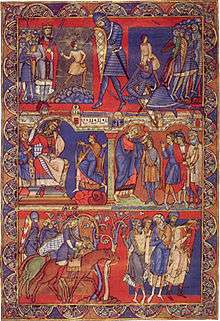Winchester Bible
The Winchester Bible is a Romanesque illuminated manuscript produced in Winchester between 1160 and 1175. With folios measuring 583 x 396 mm., it is the largest surviving 12th-century English Bible.[1] It may still be seen at the Winchester Cathedral Library, its home for more than eight hundred years.
During the Romanesque period, the focus of major illumination in the West moved from the Gospel Book to the Psalter and the Bible, and the Winchester manuscript is one of the most lavish.
The Bible comprises 468 leaves of calf-skin parchment. Given the large size of the pages, each bifolium required an entire skin: it is estimated that the manuscript incorporated the hides of some 250 calves.[2] Its first recorded mention, in 1622, describes the manuscript as a Bible in two volumes.[1] Over the years it has been rebound twice, first in 1820, when it was divided into three volumes, and again in 1948. The Bible now spans four separate volumes bound in gold-tooled cream-coloured leather.
Although many of the illuminations remain unfinished, the Latin text itself is complete. Unusually, nearly the entire manuscript is in the hand of a single scribe, save for a few minor additions. Most manuscripts of this length would employ two or more scribes. It is estimated that the task of transcribing the entire Vulgate, here comprising both Old and New Testaments, two versions of the Psalms, and the Apocrypha, would have taken him some four years.[2]
In contrast, the illuminations reflect the work of at least six different hands. The art historian Walter Oakeshott first identified and named these artists in 1945,[3] referring to them as the Master of the Leaping Figures, the Master of the Apocrypha Drawings, the Master of the Genesis Initial, the Master of the Amalekite, the Master of the Morgan Leaf, and the Master of the Gothic Majesty. Close examination of the illustration often reveals the work of two separate hands, with one providing the original sketch or design and the other painting in the colour and details.
The artwork of the Winchester Bible is incomplete: many illuminations were left unfinished, while others were deliberately removed. The illuminations throughout the manuscript appear in varying stages of completion, ranging from rough outlines and inked drawings to unpainted gilded images and figures complete in all but the final details. In all, 48 of the major historiated initials that begin each book stand complete.[4]
Over the years, the manuscript has suffered at the hands of thieves and collectors. Some nine illuminated initials and at least one full-page illustration have been removed entirely. Of these, only one (the initial of Obadiah) has been recovered and restored to the text.[4] Another missing leaf, showing scenes from the lives of Samuel on the recto and of King David on the verso, is now in the Morgan Library and is commonly referred to as the Morgan Leaf. Whether other similar full-page miniatures have been removed is unknown.
References
| Wikimedia Commons has media related to Winchester Bible. |
Further reading
- Ayres, Larry M. (June 1974). "The Work of the Morgan Master at Winchester and English Painting of the Early Gothic Period". The Art Bulletin (login required)
|format=requires|url=(help). 56 (2): 201–223. doi:10.2307/3049226. JSTOR 3049226. OCLC 38436072. - Oakeshott, Walter (1972). Sigena: Romanesque Painting in Spain & the Winchester Bible Artists. London: Harvey, Miller and Medcalf. ISBN 0-8212-0497-1.
- Oakeshott, Walter (1981). The Two Winchester Bibles. New York: Oxford University Press. ISBN 0-19-818235-X.
Gallery
 Fol.169. Lamentations 5. The prayer of Jeremiah
Fol.169. Lamentations 5. The prayer of Jeremiah- Fol.5, detail. Christ at the Last Judgment
- Fol.120v. Beginning of Second Kings with historiated initial showing the messengers of Elijah and Ahaziah
 The Morgan Leaf. Scenes from the life of King David
The Morgan Leaf. Scenes from the life of King David